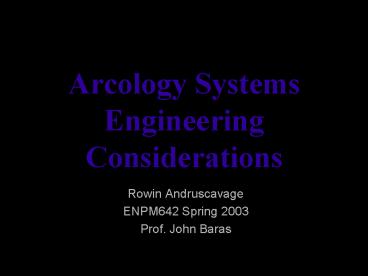Arcology Systems Engineering Considerations - PowerPoint PPT Presentation
1 / 17
Title: Arcology Systems Engineering Considerations
1
Arcology Systems Engineering Considerations
- Rowin Andruscavage
- ENPM642 Spring 2003
- Prof. John Baras
2
Problem
- Much SE work done to improve transportation
networks congestion due to auto traffic, rail
traffic, air traffic, port traffic, etc. - Symptoms of underlying problems with fundamental
city design - Solution apply SE methods to urban design
planning - Throw in some aesthetics
- ARCOLOGY
3
Systems Engineering Approach
- Goals Use Cases
- Structural Model
- Behavioral Model
- System Requirements Allocation
- Specifications
- Tradeoff Analysis
- Optimization Criteria
- Problem Formulation
- Pareto Optimal Curves
4
Goals Use Cases The Sims Example
5
Goals Use Cases
6
System Structure
7
System StructureExample
8
System Behavior
9
System Requirements
Arcology Primitive Requirements 1. Attend to
basic occupant needs defined in the Individual
use cases described in Live. 1.1. Provisions
(Feed) 1.1.1. Food 1.1.2.
Water 1.1.3. Other consumables (vitamins,
nutrients, etc.) 1.2. Indirect assets
qualities 1.2.1. Shelter, security
(Sleep) 1.2.2. Health, hygiene maintenance
not covered by 1.1.3 (Maintenance) 1.2.2.1.
Waste removal 2. Self-sufficiency
sustainability (Work) 2.1. Extract required
resources from environment 2.2. Extract labor
from occupants 3. Improve quality of life
for occupants (Entertain) 3.1.
Education 3.2. Entertainment 3.3. Social
interaction
Arcology Derived Requirements 1.
Transformations of resources 1.1. Fuel to Waste
- byproducts of Arcology Requirements 1 1.2.
Construction / deconstruction mechanism -
resulting from 2.2 2. Accounting
transportation mechanism for resources 2.1.
Solid - Arcology Requirements 1.1 2.2. Liquid -
Arcology Requirements 1.1 2.3. Gaseous -
Arcology Requirements 1.1 2.4. Information -
Arcology Requirements 3.1,3.2 2.5. Monetary
credits - intermediary between exchanges and
transformations. 3. Transportation mechanism
for resources occupants in order to satisfy all
of the above (Travel)
10
System Specifications
For Arcology Primitive Requirements 1.
Attend to basic occupant needs defined in the
Individual use cases described in Live. 1.1.
Provisions 1.1.1. Food gt 1.77 kg per
diem 1.1.2. Water gt 2.3 kg per
diem 1.1.3. Other consumables (vitamins,
nutrients, etc.) 1.2. Indirect assets
qualities 1.2.1. Shelter, security
distribution of 5 - 10 hours of sleep, personal
living quarters with gt 37 m2 of personal living
space. 1.2.2. Health, hygiene maintenance
not covered by 1.1.3 timely delivery of
emergency supplies services. 1.2.2.1.
Waste removal roughly equivalent to total of
Provisions. 2. Self-sufficiency
sustainability 2.1. Extract required resources
from environment varies, should balance with
environmental production rates, if known. 2.2.
Extract labor from occupants a distribution of
around 1/3 of the daily cycle. Provide gt 19 m2
of work space. 3. Improve quality of life
for occupants continually increase amount of
leftover time dedicated to the following 3.1.
Education 3.2. Entertainment 3.3. Social
interaction
For Arcology Derived Requirements 1.
Transformations of resources 1.1. Fuel to Waste
roughly 1 to 1 conversion factor by
weight. 1.2. Construction / deconstruction
mechanism 2. Accounting transportation
mechanism for resources Conversion, creation,
consumption of each class of resource. 3.
Transportation mechanism for resources
occupants 3.1. Quantify measures of
effectiveness cost, latency, throughput,
efficiency
11
Tradeoff Analysis
- Transportation network design for resource
distribution via mass transit - Each node has unique resources that must be
distributed to other nodes - Hub nodes are proportionally larger both in
resource pools and capacity - Multi-Criteria optimization
- max Profit (revenues operating costs)
- max coverage (min unserved units)
- min change to current fleet size
12
LP Formulation
- Constructed as an inventory management problem
- 4 main sets of variables
- Ptijk people from node i going to node j at
time t with final destination k - Ftsij flights of type s from node i going to
node j at time t - PPtik pool of people at node i at time t
whose destination is node k - APtsi pool of aircraft of type s at node i
at time t
Node 1
AP
p31
p12
p13
AP
p21
Node 3
p32
AP
p23
Node 2
13
Pareto Optimal Curves- Unserved units vs.
Deviation from fleet size
14
Pareto Optimal Curves- Profit vs. Deviations
from fleet size
15
Pareto Optimal Curves- Profit vs. Unserved units
16
Analysis Conclusions
- Tradeoff curves are a bit too linear to be
interesting need to tweak inputs to find more
complex regions - Need to really tweak inputs in order to get
non-trivial results optimization criteria not
strongly opposed to each other
- Useful for finding slope of coverage line,
allowing tradeoff between cost and maximum
coverage, stable fleet size.
17
Future Work,Questions Discussion
- Design of Experiments parametric analysis of
model inputs for preliminary design. - Verification, Validation































